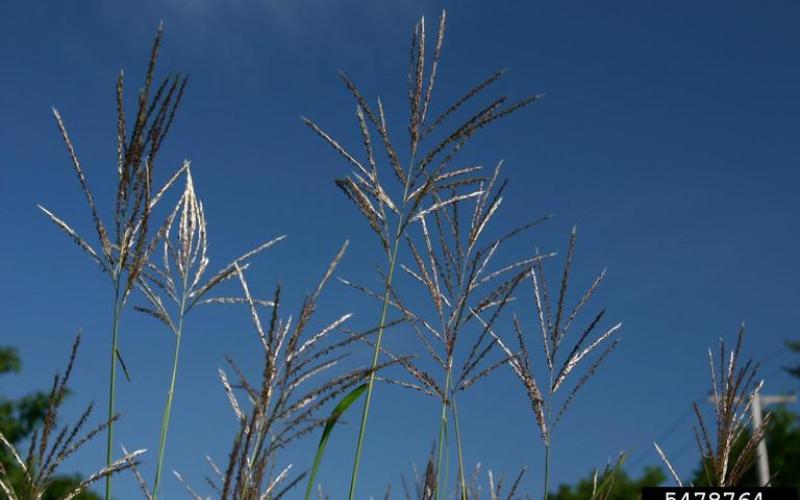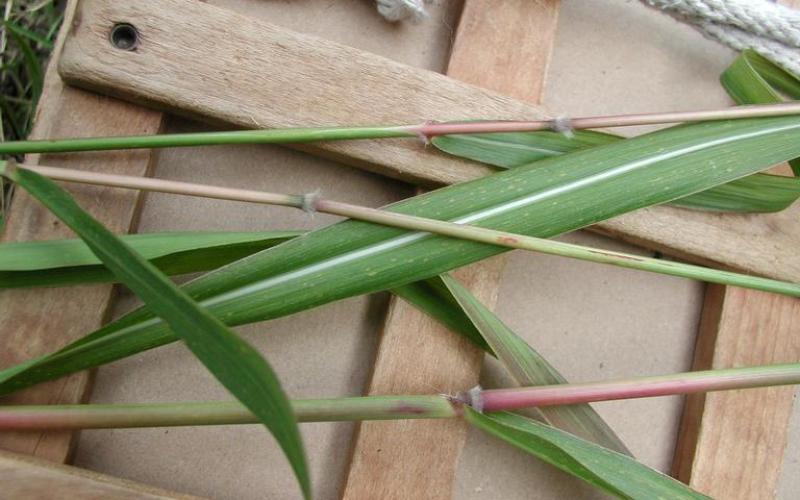Common names: Creeping miscanthus, Silver Banner Grass
Scientific name: Miscanthus saccariflorus (Maxim.) Franch.
Alternate name: Amur silvergrass
Legal status
Propagation and sale of this plant are prohibited in Minnesota. Transportation is only allowed when in compliance with Minnesota Statute 18.82. Although Restricted Noxious Weeds are not required to be controlled or eradicated by law, landowners are strongly encouraged to manage these invasive plants on their properties to reduce spread into new areas.
Background
Creeping miscanthus was first introduced to the United States in the late 1800s and has been used for decades as an ornamental landscape species. It is a perennial warm season grass that turns reddish orange with showy white flowerheads in the fall.
Description
- Creeping miscanthus is a perennial grass that grows 6 to 8 feet tall. It is an attractive ornamental and grows vigorously, forming dense colonies.
- The leaves of creeping miscanthus are arching, light green with a white midrib. They are less than 1 inch wide, blade-like, and sprout from nodes along the stem. The edges of the leaves are saw-toothed and sharp. They can potentially cut, so gloves should be worn when working with this plant.
- The flower of creeping miscanthus is plume-like, resembling corn tassels, and held high above the foliage. It is silver in color when opening, becoming fluffy and white when ripe. They begin to bloom in late summer to early autumn, and when dry, often persist through winter months. The inflorescence ofcreeping miscanthus is smaller and upright, its relative M. sinensis, tends to be droopier.
- Seeds are small and covered in long hairs.
- Stem is pale yellow to green in the growing season, becoming red to pale brown in the fall. Stem nodes are covered with hair-like structures.
- Roots are rhizomatous and grow from underground stems.
Habitat
Creeping miscanthus prefers wet soils but will grow in any soil if it is not too dry. It may spread easier in moist areas than dry areas. It prefers full sun but may also grow in partial shade.
It is native to wet lowlands in northeastern China, Korea, Japan, and Russia. It can invade disturbed habitats, and in Minnesota is often seen around pond edges, woodland edges, or railways.
Means of spread and distribution
Creeping miscanthus mainly spreads via rhizomatous roots. Rhizome fragments that move to new locations, for example via flooding, can result in a new infestation. Low levels of seed production have been documented in Minnesota and Iowa. It is more likely to spread in wet areas, such as along stream corridors or pond edges. It is quite tolerant of wind, its flowers are wind pollinated and seeds are dispersed by wind.
Creeping miscanthus can be found planted as an ornamental across many areas of the United States, especially the Northeast and the Midwest. It has been known to escape plantings and invade nearby natural areas.
Its potential ability to hybridize with M. sinensis may be an issue as hybrids of these two species may be able to produce prolific amounts of seed. Hybrids have been documented in Japan and Korea.
Impact
Creeping miscanthus can form quite large monocultures, and these are typically quite dense. Because of that growth form, creeping miscanthus crowds out native plants. It tends to escape when planted ornamentally and can spread via roadsides to sunny, open areas such as native prairies or woodland borders.
Prevention and management
- Prevent the spread by not planting this species as an ornamental and working on eradication of any existing plants in your yard or property.
- Management is best done with a combination of chemical and mechanical means.
- Hand pulling, ensuring to get the entire root, may be possible on small infestations. Hand pulling is best done prior to flowering. Monitoring and follow up will need to happen to get re-sprouts. Herbicide control is best done in late winter or early spring as plants are 1 foot tall. Contact U of M Extension for best herbicide recommendations.
- Mowing is best done twice per season while actively growing, or monthly, if possible, followed by herbicide work. Dormant mowing will encourage spring growth, so do not mow at that time.
- Flowerheads or plumes should be cut and bagged in the fall to prevent the potential spread of seed.
- Fire can encourage more growth; fire could knock it back but should be followed up by herbicide control.




